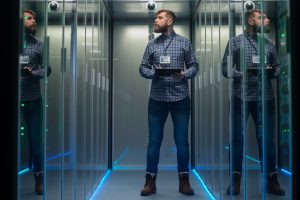Most data centers have some sort of backup power plan to protect IT equipment in the event of a power outage. Typically it involves the use of uninterruptible power supplies (UPSs) to supply power until generators kick in. That’s all well and good, but if the data center cooling system is not similarly accounted for, the IT equipment may suffer outages anyway as you’re going to have one hot data center.
The question is, how hot will it get and how soon? That’s the focus of a new, free course at Schneider Electric’s Energy University, “Data Center Temperature Rise During A Cooling Power Failure.”
The course goes into the factors that affect the rate at which a data center will heat up – some of which are counterintuitive. For example, you’ll learn why even the “hot” insides of a server can contribute to slowing the rate at which a data center will heat up during a cooling outage. You’ll also learn why chilled-water systems featuring traditional CRAHs or row-based coolers offer advantages over fluid and air-cooled DX systems during a power failure.
The course uses two models to illustrate what to expect in the event of a cooling system outage. One is a “well-mixed air” model that assumes a single, uniform data center air temperature, plenum temperature, cooler supply temperature, etc. The other is a computational fluid dynamics (CFD) model that provides a far more detailed view of the temperature of individual data center components, pointing out potential trouble spots.
In either case, you’ll see examples of how data center temperatures may rise immediately following a power outage, what happens after backup generators kick in and how long temperatures may be too high.
Certain industry trends with respect to data centers are also conspiring to make it more challenging for cooling systems to survive a power outage. You’ll learn about several of them, including:
- Right-sizing of cooling capacity (aligning capacity to the actual IT load, with little excess)
- Increasing rack power density and virtualization
- Increasing IT inlet and chiller set point temperatures, in accordance with ASHRAE guidelines
- Use of air containment systems for rows and racks
Don’t panic if you’re implementing all of the above, as the course will educate you on how to compensate. You’ll learn about four strategies for surviving a cooling outage:
- Maintain adequate reserve cooling capacity
- Connect cooling equipment to backup power
- Use equipment with shorter restart times
- Use thermal storage to ride out chiller-restart time
The course goes into some detail on each of them, including variables to consider, such as when your cooling system may need a UPS that’s independent of that used for IT equipment.
In less than an hour, “Data Center Temperature Rise During A Cooling Power Failure” will bring you up to speed on the steps you need to take to ensure your data center doesn’t overheat during a power failure. And, like all of Schneider Electric’s Energy University courses, it’s free. You’ll find it in the College of Data Centers at Schneider Electric’s Energy University.



